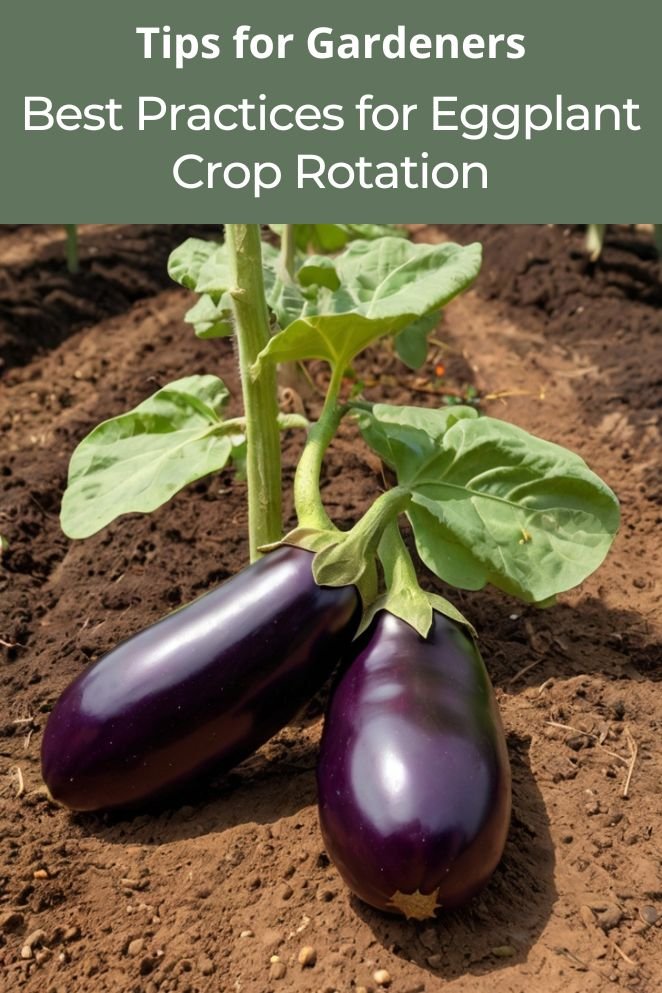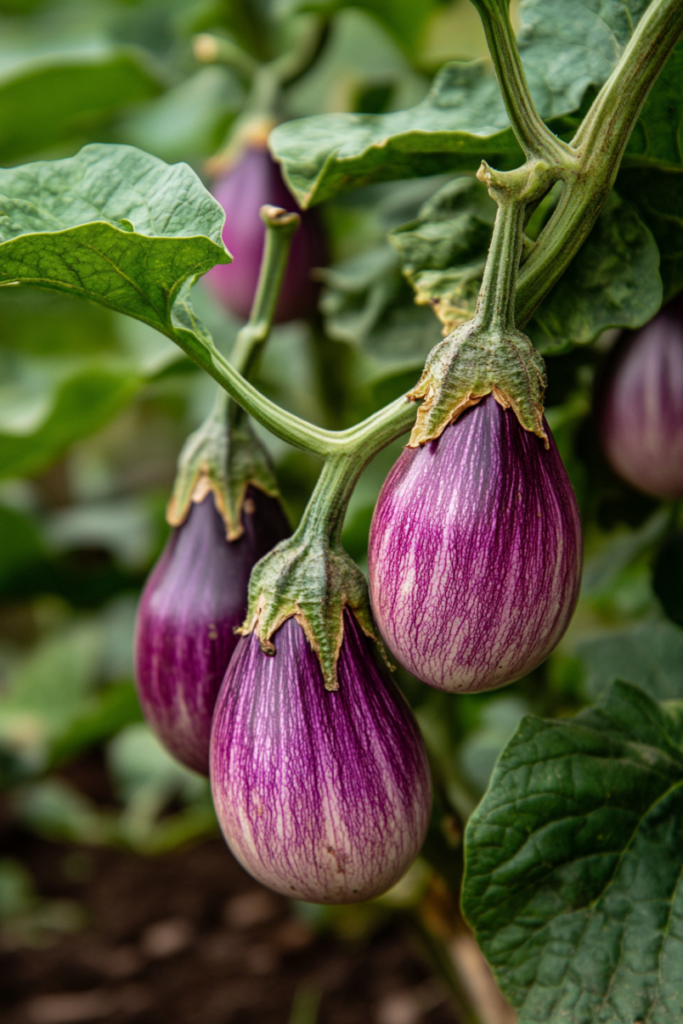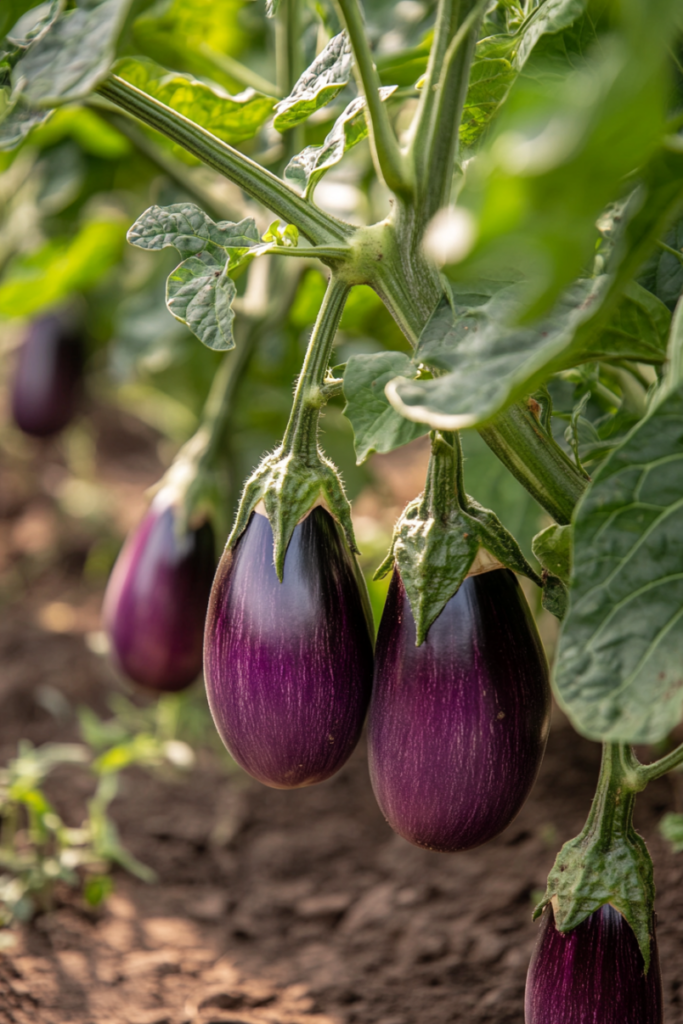
Crop rotation is an essential practice for maintaining healthy soil, reducing the risk of pests and diseases, and improving crop yields.
For eggplant growers, understanding the best practices for crop rotation can make a significant difference in the health and productivity of their plants.
Let’s explore the key principles of eggplant crop rotation and how to effectively plan your garden for optimal results.
Why Crop Rotation Matters for Eggplant
To maintain healthy soil and ensure a productive garden, rotating your eggplants with other crops is crucial.
Here are the key reasons crop rotation benefits eggplants:
Prevents nutrient depletion
Eggplants are heavy feeders, meaning they use up a lot of essential nutrients from the soil, particularly nitrogen, phosphorus, and potassium.
If you plant eggplants in the same spot year after year, these nutrients get exhausted, leading to poor growth and lower yields.
- Read also: Organic Eggplant Care: Growing Healthy, Chemical-Free Eggplants
- Read also: Boost Your Harvest! The Ultimate Guide to Eggplant Fertilizer
Reduces the risk of soil-borne diseases
Soil-borne diseases, like verticillium wilt, can build up when the same crop is grown repeatedly in the same area.
These diseases are especially harmful to plants in the nightshade family, like eggplants. Rotating crops breaks this cycle and reduces disease risks.
Controls pest infestations
Eggplants attract pests such as nematodes, aphids, and Colorado potato beetles, which can survive in the soil and attack new crops.
Crop rotation helps manage these pests by disrupting their life cycles.
Planting crops like marigolds or nasturtiums after eggplants can even help repel some pests, like nematodes.
Improves soil structure and health
Growing the same crop in the same spot repeatedly can damage the soil, leading to compaction and poor water retention.
Rotating crops helps maintain healthy soil structure and promotes biodiversity.

Best Practices for Eggplant Crop Rotation
Rotate every 3-4 years
Avoid planting eggplants in the same location for at least three to four years.
This rotation period gives the soil a chance to recover and reduces the buildup of pests and diseases specific to the Solanaceae family.
Rotating with unrelated crop families ensures healthier soil conditions.
Choose non-nightshade crops
Never rotate eggplants with tomatoes, peppers, or potatoes, as they all belong to the nightshade family.
Planting these crops after one another increases the risk of soil-borne diseases like fusarium wilt, blight, and root-knot nematodes, which persist in the soil and affect all Solanaceae members.
Since eggplants are part of the Solanaceae family, you should rotate them with crops from different families to break pest and disease cycles.
Good options include:
- Legumes (Fabaceae): Beans, peas, and lentils. Legumes fix nitrogen in the soil, replenishing nutrients that eggplants deplete.
- Brassicas (Brassicaceae): Cabbage, broccoli, kale. These crops improve soil structure and don’t share common pests with eggplants.
- Leafy greens (Amaranthaceae or Asteraceae): Spinach, lettuce, or Swiss chard. These light feeders are ideal to follow after heavy feeders like eggplants.
Improve soil fertility
Eggplants consume a lot of nutrients, particularly nitrogen, potassium, and phosphorus.
To maintain soil fertility, plant legumes before or after eggplants.
Legumes help replenish nitrogen, one of the key nutrients that eggplants require in large amounts.
Legumes have symbiotic relationships with bacteria that can convert atmospheric nitrogen into a form that plants can use.
This process is known as nitrogen fixation.
By including legumes in your crop rotation, you can reduce the need for synthetic nitrogen fertilizers and improve soil fertility.
Consider using green manure crops
Green manure crops are plants that are grown specifically to be plowed back into the soil.
These plants can help improve soil structure, increase organic matter content, and suppress weeds.
Some popular green manure crops for eggplant include mustard, rye, and clover.
Green manure crops can help to improve soil health, which can lead to better plant growth and higher yields.
Monitoring soil health
Regular soil testing is essential for maintaining healthy soil and ensuring that your eggplant plants have the nutrients they need.
By testing your soil, you can identify any nutrient deficiencies or imbalances.
Soil tests typically measure pH, organic matter content, and nutrient levels (such as nitrogen, phosphorus, and potassium).
Based on the results of your soil test, you can make adjustments to your crop rotation plan or apply appropriate fertilizers or amendments.

Planning Eggplant Crop Rotation
Planning an effective crop rotation for your eggplants ensures that your garden remains healthy, productive, and free from soil-borne pests and diseases.
Proper crop rotation also helps maintain nutrient balance in the soil.
Below is a step-by-step guide to planning your eggplant crop rotation.
Step 1: Group crops by plant families
Start by grouping the crops in your garden by their botanical family.
Eggplants belong to the Solanaceae family (nightshade family), which also includes tomatoes, peppers, and potatoes.
When planning crop rotation, avoid planting other members of this family in the same plot immediately after growing eggplants to minimize the risk of disease and pest carryover.
- Solanaceae (Nightshades): Eggplant, tomato, pepper, potato.
- Fabaceae (Legumes): Beans, peas, lentils (help fix nitrogen in the soil).
- Brassicaceae (Cabbage Family): Cabbage, broccoli, kale, cauliflower.
- Amaranthaceae: Spinach, beets, Swiss chard.
Step 2: Choose rotation cycles
Aim to rotate your eggplant crops on a 3-4 year cycle to allow the soil time to recover and to break the cycle of pests and diseases that affect eggplants and other nightshades.
This means you should not plant eggplants (or other nightshades) in the same plot for at least three years.
Example cycle:
- Year 1: Eggplants (Solanaceae).
- Year 2: Legumes (beans or peas) to restore nitrogen.
- Year 3: Brassicas (cabbage, broccoli) to enhance soil structure.
- Year 4: Leafy greens (spinach, lettuce) or root vegetables (carrots, beets) before returning to eggplants.
Step 3: Rotate heavy Feeders, light feeders, and nitrogen-fixers
Different crops have different nutrient needs. Eggplants are heavy feeders, meaning they deplete a lot of nutrients, especially nitrogen.
After growing eggplants, rotate in nitrogen-fixing plants or light feeders to balance soil fertility.
- Heavy feeders: Eggplant, tomatoes, peppers.
- Light feeders: Leafy greens, root vegetables.
- Nitrogen-fixers: Legumes (beans, peas).
Step 4: Plan for soil fertility and pest management
- Legumes after eggplants: Plant legumes like beans or peas in the season following eggplants. Legumes are nitrogen-fixing crops that will replenish the nitrogen levels in the soil.
- Use cover crops: In off-seasons, consider planting cover crops (e.g., clover, rye) to improve soil health. These plants add organic matter to the soil, enhance structure, and suppress weeds.
Step 5: Record and rotate
Keep a garden journal or chart of what you plant and where each year.
This ensures you can track which crops have been grown in which beds, so you don’t accidentally plant eggplants (or other nightshades) too soon in the same spot.
Sample rotation chart:
| Year | Plot 1 (Eggplant) | Plot 2 (Legumes) | Plot 3 (Brassicas) | Plot 4 (Leafy greens) |
| Year 1 | Eggplants | Beans/Peas | Cabbage/Broccoli | Spinach/Carrots |
| Year 2 | Beans/Peas | Cabbage/Broccoli | Spinach/Carrots | Eggplants |
| Year 3 | Cabbage/Broccoli | Spinach/Carrots | Eggplants | Beans/Peas |
| Year 4 | Spinach/Carrots | Eggplants | Beans/Peas | Cabbage/Broccoli |
Step 6: Consider companion planting
Incorporating companion plants into your crop rotation plan can boost the health of your eggplants.
Some plants repel pests or improve soil conditions for future crops.
For instance, marigolds planted near eggplants help control nematodes.
Step 7: Be flexible and adapt to your garden’s needs
While a 3-4 year rotation is ideal, sometimes smaller gardens require adjustments.
Rotate crops as best as possible while maintaining soil health.
If disease strikes, avoid planting the same crop family in the affected area for even longer than planned.
- Read also: Eggplant Yellow Leaves: How to Diagnose and Fix the Problem
- Read also: Eggplant Blossom End Rot: Causes, Symptoms, and Effective Management

Conclusion
In summary, crop rotation is essential for growing eggplants successfully.
It helps prevent nutrient depletion, reduces the risk of soil-borne diseases, controls pests, and improves overall soil health.
By rotating eggplants with different types of crops, you create a more balanced and sustainable growing environment, leading to healthier plants and better yields.



